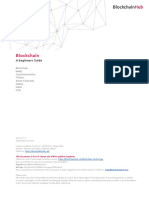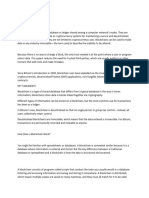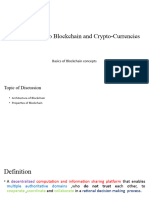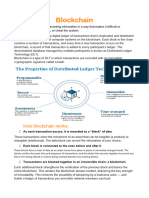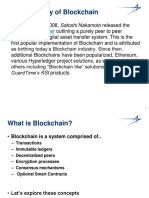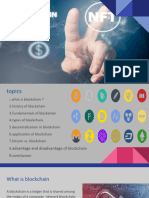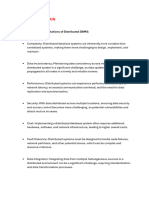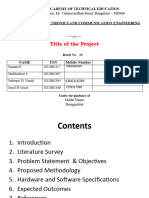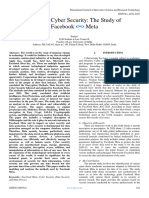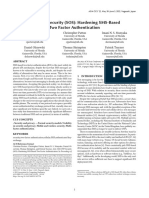What is Blockchain?
1
�What is Blockchain?
● Blockchain is a distributed database existing on various computers at the same time.
● A decentralized ledger tracking digital assets on P2P network.
● Some analogies for Blockchain.
Any real life example?
❖ Records your sale & purchase of raw material
❖ Even your bank account statements
❖ An excel sheet tracking all hospital equipments
❖ Simply a large sized book
2
�Book Analogy
Imagine it as a traditional book based ledger, where each page refers to a block connected to the
previous page through a page number
Book = Blockchain, Page = Block, an entry in page = blockchain transaction
Easy to detect if a page/block has been removed or deleted
Easy to arrange the pages/blocks & identify suspicious activity. That’s why page numbers are important in
a ledger.
Since the pages/blocks are built tightly on top of each other it is impossible to tamper a previous entry in
the ledger without someone noticing it.
3
�Peek Inside Blockchain
4
�More on Blockchain
● In case of a real Blockchain, each block is built on top of the new block using the previous block’s
content/signature + Nonce (random string).
● Building a block & adding it in the Blockchain is a task of miner nodes (optional).
● In public Blockchain, it is made computationally difficult to add a block to prevent attacks.
● Miners try to guess a number (nonce) in such a way that if it gets crunched with the most recent
block’s fingerprint, then it will create a new fingerprint for the Block.
● It takes time & computational power to add a Block in the Blockchain. Hence there is a reward (12.5
BTC in case of Bitcoin Blockchain, 5 ETH in Ethereum)
● Private Blockchains can choose other methods to add a block as they can trust the miners using a
contract etc.
5
�Make you own Definition for Blockchain
Let's build our definition
● It’s a decentralised database which stores information in the form of transactions
● It can be public or private
● Stored data is immutable
● Highly secure
● Data gets recorded via consensus-based algorithms
● Uses cryptography
● Generally, exists over a peer-to-peer network
So here is our definition:
“Blockchain is a consensus-based secure decentralised public/private database which stores
information immutably over a peer-to-peer network”.
6
�Summary
● It is a decentralised distributed ledger (data structure) where data is being stored inside blocks in the
form of transactions.
● Removes the dependency on a trusted third party for recording the data in blocks.
● In public Blockchains, more complex algorithms are required to avoid malicious activities.
● Since each block is built on top of the previous block, the immutability has been achieved.
● Here immutability means, it is difficult to fake/alter a block & very easy to detect the tampering.
● This all exists in the memory of the computers and runs as a computer process.
● Every participant in Blockchain contains an almost same copy of the Blockchain ledger.
7
�THANK YOU!
Any questions?
You can mail us at
hello@blockchain-council.org





